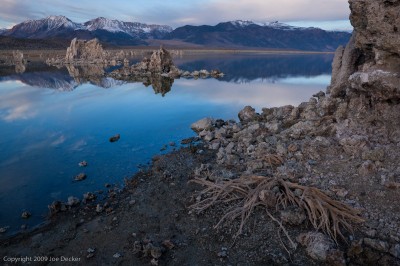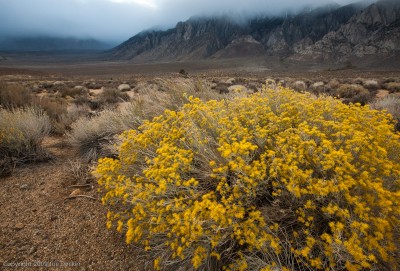
If you like this article, you can now get the book! Joe has expanded the “Tuesday Composition” series into an inspiring new ebook on composition, especially for nature photography. Check it out: The Tuesday Composition.
One of the more common idioms in landscape of photography is the near-far composition, a powerful technique for creating depth and relationships within a photograph.
In a near-far composition, a small foreground element is emphasized and placed in a background that establishes context for that element. For example, the dead bush in Bleached Bush Skeleton, the bush remains are the subject of the photograph. The lake, the tufa in the lake and the Sierra Nevada all tell us something about the location the bush remains are in.
Put another way, if you were to try and write a sentence describing what a near-far photograph is about, it would usually be something like, “This foreground (thing) is in the background (environment).” The foreground object is the subject of the sentence, it is in general the more important of the two elements in a near-far image.
When I say that the foreground is emphasized, it’s important to be clear about how that’s done. For the foreground to be comparable in size to the background, it needs to be much closer to the lens than the background. While it might seem in theory that this could be accomplished with almost any sort of lens, the smaller depth-of-field of telephoto lenses often make it impossible to keep near and far objects both in focus. As a result, the most dramatic near-far compositions are usually made with wide-angle lenses. Hyperfocal focusing is often used to create the greatest depth-of-field.
Sometimes a near-far composition can work well even if the background is out of focus, but only if the backgrounds stays identifiable. In some situations this can be a benefit, blurring away small distracting details, and/or helping the eye gravitate first to the foreground object. But be conscious of whether the viewer can still “see” what the background is–once you’ve blurred the background to the point where, they can’t, you may still have a great photograph but it’s not a near-far composition, and the meaning of the photograph is changed as a result.

Don’t shy away from getting quite close to your foreground subject. With that wide angle lens, your small foreground object just won’t be that emphatic unless it’s close to the lens. This will require a lot of patience in carefully adjusting the position of your tripod, careful attention to depth-of-field, and occasionally a bit of yoga to see through the viewfinder.
The emphasis of the foreground is, well, an emphasis on the foreground. If you’re emphasizing it, make sure it’s interesting. One of the most common mistakes I see in students trying out near-far like compositions are weak foreground subjects. If you’ve got a field of flowers and you want to make one the star, it’s essential that you spend some time searching through the field for a good one.
Near-far compositions are simple, and common enough that you won’t have trouble finding dozens of other examples to investigate. But that shouldn’t deter you from creating your own. The reason near-far compositions are common is that they work, providing a method for communicating depth, power and relationships within an image. Give ’em a try, and drop me a link to some of your own near-far images, I’d love to see them!
Fernando (SPAIN)
20 Oct 2009Thank you,
I´ve found this post very interesting. I discovered this site recently and I must say I´m happy with it. I´m learning a lot of important and valuable things.
Good job, boys! Thanks for sharing your amazing know-how.
Erick Danzer
21 Oct 2009Joe, this series is awesome. I love Tuesday Composition. And your photography is just awesome.
I wanted to add that what you call the near-far principle operates in travel photography and photojournalism as well. I often think of this as the key to great use of wide-angle lenses even when shooting street photojournalism with people. Wide-angle shots can often be underwhelming if there’s not something to fill the foreground. I like to do wide angle portraits with person in the foreground, perhaps off to the side, perhaps looking off the frame, and with something interesting in the background.
Of course to do this, you have to – as you say – not be afraid of getting close to your subject. If your subject is people, then that means you’ve got to have a relationship with them before you can do that sort of thing.
And that also makes me think of the famous dictum in photojournalism – if your photos aren’t good, then you’re not close enough.